Vol. 2, No. 3
- - - - - - - - - - - - - - - - - - - - - - - - - - - - - - - - - - - - - - - - - - - - - - - - In this issue:
In this issue:
reviews of All-Star Superman #2 and JSA #82 / notes on One Year Later, Frankenstein/Swamp Thing, goatees in Green Arrow, Alpha Flight, Moon Knight, and more Quizilla nonsense / rants about buttons (yes, you heard me: buttons)
- - - - - - - - - - - - - - - - - - - - - - - - - - - - - - - - - - - - - - - - - - - - - - - -
reviews
All-Star Superman #2 (DC Comics)
Grant Morrison (Writer) / Frank Quitely (Penciller) / Jamie Grant (Inker and Colorist) / Phil Balsman (Letterer)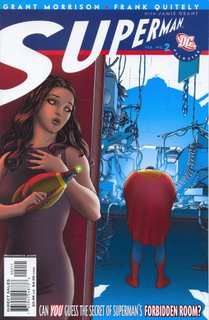 A brilliant follow-up to the first issue—but you knew I’d say that, didn’t you?
A brilliant follow-up to the first issue—but you knew I’d say that, didn’t you?
There is, surely, enough patented Morrison/Quitely-style “wonder” in Lois’s tour of the Fortress of Solitude to seduce even the sternest critic of Morrisonian future-nostalgia. As always, Morrison’s imagination thrives on breathtakingly simple “hey-why-didn’t-I-think-of-that?” contrasts of scale that make us gasp precisely because their grandeur seems so elemental. The page on which Superman makes like Hephaestus at the forge to create miniature suns on a cosmic anvil to feed his baby Sun-Eater, for instance, is magnificent. Pure magic.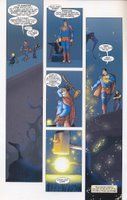 The heart of this issue, though, is not Superman’s god-like stature (he makes little suns to feed his pet!), but his newly discovered mortal dilemma: how to tell Lois that he is dying from his exposure to the heart of the sun in issue #1. His dinner with Lois aboard the real Titanic—that ultimate symbol of hubris brought low—picks up on the Icarus motif of the first issue and obviously symbolizes Superman’s own impending doom as he tries once again to convince Lois that he and Clark Kent are the same person—to no avail. This is, of course, only a half-confession, pointing in the direction of that ultimate confession that he is, for all intents and purposes, no longer a superman, but merely a man.
The heart of this issue, though, is not Superman’s god-like stature (he makes little suns to feed his pet!), but his newly discovered mortal dilemma: how to tell Lois that he is dying from his exposure to the heart of the sun in issue #1. His dinner with Lois aboard the real Titanic—that ultimate symbol of hubris brought low—picks up on the Icarus motif of the first issue and obviously symbolizes Superman’s own impending doom as he tries once again to convince Lois that he and Clark Kent are the same person—to no avail. This is, of course, only a half-confession, pointing in the direction of that ultimate confession that he is, for all intents and purposes, no longer a superman, but merely a man. The scene where a slouchy Clark Kent looks at his buff Superman reflection in a mirror epitomizes this melancholy situation. “Superman” is now just an image in a glass—only mortal Clark Kent is real.
The scene where a slouchy Clark Kent looks at his buff Superman reflection in a mirror epitomizes this melancholy situation. “Superman” is now just an image in a glass—only mortal Clark Kent is real.
Superman’s birthday surprise of a temporary power-granting supersuit for Lois is thus particularly touching. Already on page 4, Superman is talking about sidekicks and telling Lois, “I always wondered if I should have taken a partner.” In a very real sense, of course, Lois herself already is Superman’s partner. But this isn’t quite what he means, and we can understand why, even under the best of circumstances, Lois might have some difficulty imagining a “partnership” with Superman that did not seem distressingly unequal. (Under the influence of the paranoia-inducing alien chemicals from Superman’s lab, Lois imagines that he has brought her to the Fortress “to be the mother of a race of deformed superhuman horrors.”) What Lois doesn’t realize yet is that the dying Superman’s handiwork on a super sewing machine with diamond-tipped needles has made it possible for her to be a more genuine partner to Superman (at least for 24 hours). This gift also hints that Superman’s own fantasy is that Lois might one day serve as his replacement. “One day some future man or woman will open that door with that key,” Superman tells Lois on page 9, shortly after Lois has found herself unable to lift the half a million ton key made of “super-dense dwarf star material.”  Lois could well become that future woman, though she would do so, ultimately, as Superman’s heir, not his partner. What we might be watching over the course of the issue is a superman making the first tentative preparations for passing on his legacy in the face of his own impending death. For this reason, (from Superman’s perspective) his presentation of her birthday gift is limned with sadness. He will get his partner—but only for a brief time.
Lois could well become that future woman, though she would do so, ultimately, as Superman’s heir, not his partner. What we might be watching over the course of the issue is a superman making the first tentative preparations for passing on his legacy in the face of his own impending death. For this reason, (from Superman’s perspective) his presentation of her birthday gift is limned with sadness. He will get his partner—but only for a brief time. Of course, we may not feel the pathos of this situation viscerally because the story is told mainly from Lois’s perspective, and through this expedient, Morrison and Quitely keep the tone marvelously light. As a reading experience, “Superman’s Forbidden Room” is a sort of ironic variant on the Bluebeard story in which the heroine is lured to a castle owned by a powerful patriarch, given the run of the entire fortress, but forbidden to enter one secret chamber, where she will discover both terrible knowledge and her ultimate fate. (Marc Singer pointed out the Bluebeard connection here.) In the Bluebeard fairytale, as everyone knows, the heroine is the patriarch’s new wife and Bluebeard himself is a sort of homicidal serial monogamist who kills every woman that he marries; the secret chamber contains their severed heads mounted on the wall, and his newest wife is of course unable to resist transgressing the fatal interdiction not to enter.
Of course, we may not feel the pathos of this situation viscerally because the story is told mainly from Lois’s perspective, and through this expedient, Morrison and Quitely keep the tone marvelously light. As a reading experience, “Superman’s Forbidden Room” is a sort of ironic variant on the Bluebeard story in which the heroine is lured to a castle owned by a powerful patriarch, given the run of the entire fortress, but forbidden to enter one secret chamber, where she will discover both terrible knowledge and her ultimate fate. (Marc Singer pointed out the Bluebeard connection here.) In the Bluebeard fairytale, as everyone knows, the heroine is the patriarch’s new wife and Bluebeard himself is a sort of homicidal serial monogamist who kills every woman that he marries; the secret chamber contains their severed heads mounted on the wall, and his newest wife is of course unable to resist transgressing the fatal interdiction not to enter.  (Keys abound in that story to signify the protagonist’s acquisition of forbidden knowledge—just as they do in this one.)
(Keys abound in that story to signify the protagonist’s acquisition of forbidden knowledge—just as they do in this one.)
In Morrison and Quitely’s version, however, female “transgression” is rewritten as “initiation” so that meaning of events is reversed: Lois is not married to the patriarch but independent and capable; the patriarch’s own power is on the wane and up for grabs (indeed, he sews magical garments, like a postmodern fairy godfather!); the forbidden room is not the location where the heroine will risk losing her life by being beheaded, but on the contrary will be reborn (it is Lois’s birthday) to possess the patriarch’s power. Angela Carter’s The Bloody Chamber hardly does a better job of amplifying the feminist content of the classic Bluebeard fairytale in her own brilliant narrative of female initiation and empowerment! This is the best series that DC is currently publishing, and Morrison and Quitely will no doubt be remembered as one of the best creative teams on Superman of all time. How’s that for courting controversy?
This is the best series that DC is currently publishing, and Morrison and Quitely will no doubt be remembered as one of the best creative teams on Superman of all time. How’s that for courting controversy?
JSA #82 (DC Comics)
Paul Levitz (Writer) / George Perez (Penciller) / Bob Wiacek (Inker) / Tom Smith(Colorist) / Rob Leigh (Lettererer) JSA #82 was a real treat. Paul Levitz and George Perez on JSA? Bring on the old guys!
JSA #82 was a real treat. Paul Levitz and George Perez on JSA? Bring on the old guys!
In his generally favorable review of this issue’s return to “traditional” comics storytelling, Paul King of ComicBloc Forums writes:
I want to impress you with something: There are 161 panels in this issue and one splash page. Compare this to Superman/Batman #13 drawn by popular artist Michael Turner which has 73 panels and 4 splash pages. Perez gives us almost three times the story without feeling cluttered. This goes back to my point of being ‘traditional without being antiquated’. Where Perez’s art lacks in dynamics it makes up for in craftsmanship. Each line feels planned with depth and purpose. I long for more modern comics with this level of storytelling on every page.
While I can’t agree that Perez’s art lacks “dynamics” (sacrilege, Paul!), I heartily endorse the sentiment that JSA #82 is an object lesson in the virtues of a high panel-count and “traditional” storytelling more generally. The ten-panel opening page, depicting the city at night as the “camera” gradually zooms in on the JSA’s headquarters, entering through an open panel on the roof and surprising Ma Hunkle on the stairs is a classic and classy way of establishing the story’s setting and tone. The darkness, the storm, and the seemingly violated mansion/sanctuary establish just the sort of “dark-and-stormy-night” atmosphere necessary for the ghost story that is at the heart of the Golden Age story-within-a-story in this issue, featuring Superman, Batman, Wonder Woman, and Flash battling Gentleman Ghost (one of the most visually perfect of DC’s older villains) . The rainy opening also establishes the emotional tone of the frame-story in this issue, in which Power Girl struggles with the terrible dilemma that Superman and Superboy Prime have placed on her shoulders in Infinite Crisis #3: whether or not to help replace the current Earth with the “original” Earth 2. The storm in the opening scene is a symbol of Kara’s own turbulent emotions, just as the rain anticipates the tears of the story’s final frame.
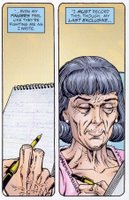 Both the frame-story and the Golden Age tale are about strong women—Power Girl and Lois Lane—who face difficult decisions. Levitz and Perez make nice contrasts between them, establishing Lois as a tireless truth-seeker and Kara as a someone for whom the very issue of truth (which is the “true” earth? Does the “truth” even matter if it means killing millions of people?) has become a moral muddle, or at least an impossible burden.
Both the frame-story and the Golden Age tale are about strong women—Power Girl and Lois Lane—who face difficult decisions. Levitz and Perez make nice contrasts between them, establishing Lois as a tireless truth-seeker and Kara as a someone for whom the very issue of truth (which is the “true” earth? Does the “truth” even matter if it means killing millions of people?) has become a moral muddle, or at least an impossible burden.
In Infinite Crisis, it is the Golden Age Lois (not Superman) who is emerging as the dying and far-seeing “spirit” or moral center of the 1950s DCU, and Power Girl is emerging as a more troubled, untested embodiment of the penetrating moral vision that Lois displays in JSA #82. “You were never too good at knowing the difference between what’s real and what’s not, dear,” Lois thinks, tellingly, about her Golden Age Clark, at the same time that she is writing her “last exclusive” about having dwelt for so long in the false “heaven” Luthor created for himself, Lois, Superman, and Superboy at the end of Crisis on Infinite Earths: “this impossible place” where “everything around us is a phony [as] Mr. Mxyztplk’s tricks…just cotton candy illusions in our minds.” One suspects, therefore, that Lois’s illness in Infinite Crisis is not due to her new proximity to what the Golden Age Superman calls the “corrupted” Earth 1, but is either simply a natural process of dying with which Lois herself is already making peace in JSA #82 (“We’ve been in this impossible place for so long that when I die, I’ll be ready for heaven or hell….I’m content Clark. Content with my life, and with facing the truth…even now”) or a symbol of the corruptions inherent in her own Superman’s black and white Old Testament morality—i.e. it is ironically his actions, spurred on by Luthor, and not the “corrupted” post-Crisis Earth 1, that are (literally?) killing her.
One suspects, therefore, that Lois’s illness in Infinite Crisis is not due to her new proximity to what the Golden Age Superman calls the “corrupted” Earth 1, but is either simply a natural process of dying with which Lois herself is already making peace in JSA #82 (“We’ve been in this impossible place for so long that when I die, I’ll be ready for heaven or hell….I’m content Clark. Content with my life, and with facing the truth…even now”) or a symbol of the corruptions inherent in her own Superman’s black and white Old Testament morality—i.e. it is ironically his actions, spurred on by Luthor, and not the “corrupted” post-Crisis Earth 1, that are (literally?) killing her.
My own current theory is that Infinite Crisis will turn out to be the final nail in the coffin of the four characters left floating on a space-rock at the end of Crisis on Infinite Earths, an extended meditation on the need to acknowledge the finality of death and the necessity of mourning. The leitmotif of “legacy” in nearly all of Geoff Johns’s work is not unrelated to this theme, for “legacy” is a secular version of the afterlife that rejects metaphysical consolations like “heaven” as so many “cotton candy illusions in our minds.” Infinite Crisis, in other words, will perhaps provide a more genuinely secular ending to the Golden Age Superman and Lois Lane than Wolfman and Perez provided in the original Crisis. (Though one could also argue, conversely, that Johns and his crew will provide a more religious ending than Wolfman and Perez did, substituting the possibility of a “real” heaven for a fake one.)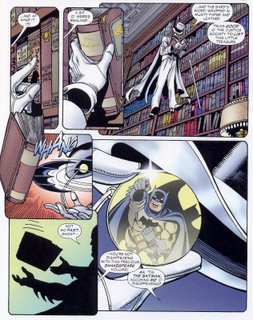 At any rate, JSA #82 adds new layers to these and other questions raised by Infinite Crisis, in addition to providing a rollicking good tale of ghostly skullduggery. The scenes where Batman scuffles with the ghost in Bruce Wayne’s library is a highlight, as are the interactions between bumbling Clark and long-suffering Lois.
At any rate, JSA #82 adds new layers to these and other questions raised by Infinite Crisis, in addition to providing a rollicking good tale of ghostly skullduggery. The scenes where Batman scuffles with the ghost in Bruce Wayne’s library is a highlight, as are the interactions between bumbling Clark and long-suffering Lois.
Oh, and one final point about Lois Lane’s steno pad and the shorthand “code” that Ma Hunkle deciphers for Power Girl. I love the prominence that DC is giving to its female characters in this story. Wonder Woman’s murder of Max Lord brought boos from some quarters, but I loved it, and I love even more the emergence of Power Girl as a major new character and the recuperation of Lois as both the heart and head of an earlier DC era. As Ma Hunkle muses near the end of this issue, “Lois was right. The men. They never get it. For all the battles, all the world-saving… We understand life and death, Karen. And what matters.” Levitz may be accused of a kind of paternalistic romanticism or hollow feminist piety for writing lines like this, but it’s hard to argue that it doesn’t make for powerful storytelling. How wonderful, then, that this issue is built around the conceit of a secret yet utterly public female “code,” the “secret code” of secretaries, a role, as Ma Hunkle observes, that, once upon a time, extended to Hippolyta herself! (“Imagine, Wonder Woman as Secretary [of the JSA]!” she says on page 4. “Good thing she had a sense of humor, back before she met Gloria Steinem and signed onto that movement of whatever it was.”) Through the use of shorthand, Levitz evokes the paradoxes of female power, historically, in the DCU, and points to the way in which one of the most important gestures of feminist thought has been the recuperation of a powerful feminist tradition that existed avant la lettre, so to speak. Hippolyta as both Wonder Woman and secretary epitomizes the way that powerful superwomen were contained by the sexism of the genre (a paradox that once applied to the Golden Age Lois as empowered reporter/girlfriend-victim as well). However, Lois’s “coded” steno pad turns this old paradox on its ear: not only is this Golden Age Lois an empowered and tireless truth seeker, she writes this truth in a semi-public code that is only interpretable by other women. What Levitz is doing in JSA #82 is glossing (and to some extent reinventing) a buried feminist tradition in DC comics. This is great storytelling, and it is great fun to watch.
notes
DCU OYL: Let Me Get This Straight…
As if the engrossing, wallet-emptying Infinite Crisis weren’t enough, over the next few months I will be enjoying: The weekly 52 series, written by Geoff Johns (!!), Grant Morrison (!!), Greg Rucka (!), and Mark Waid (!), with Keith Giffen (!) helping with plot and doing breakdowns, illustrated by Joe Bennet (!), Ken Lashley, Chris Batista, Don Kramer, Shawn Moll, Dale Eaglesham (!!), and Eddy Barrows, with covers by J. G. Jones (!).
The weekly 52 series, written by Geoff Johns (!!), Grant Morrison (!!), Greg Rucka (!), and Mark Waid (!), with Keith Giffen (!) helping with plot and doing breakdowns, illustrated by Joe Bennet (!), Ken Lashley, Chris Batista, Don Kramer, Shawn Moll, Dale Eaglesham (!!), and Eddy Barrows, with covers by J. G. Jones (!). 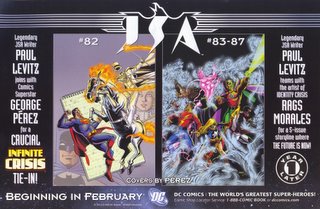 A huge JSA arc by Paul Levitz (!), Rags Morales (!!), and Luke Ross, with covers by George Perez (!!!).
A huge JSA arc by Paul Levitz (!), Rags Morales (!!), and Luke Ross, with covers by George Perez (!!!).
Justice League of America by Brad Meltzer (!!) and Ed Benes (!). James Robinson’s (!!) 8-part Batman/Detective Comics crossover, followed by Grant Morrison (!!!) becoming the regular writer on Batman.
James Robinson’s (!!) 8-part Batman/Detective Comics crossover, followed by Grant Morrison (!!!) becoming the regular writer on Batman. Geoff Johns (!!) and Kurt Busiek’s (!) Superman/Action Comics crossover.
Geoff Johns (!!) and Kurt Busiek’s (!) Superman/Action Comics crossover. Gail Simone’s (!!) new Secret Six series spinning out of my favorite mini from last year, Villains United.
Gail Simone’s (!!) new Secret Six series spinning out of my favorite mini from last year, Villains United. Greg Rucka’s (!) new Checkmate series whose characters include Fire, Amanda Waller and the Suicide Squad (!!).
Greg Rucka’s (!) new Checkmate series whose characters include Fire, Amanda Waller and the Suicide Squad (!!). An ongoing Shadowpact series written and drawn by Bill Willingham (!!).
An ongoing Shadowpact series written and drawn by Bill Willingham (!!).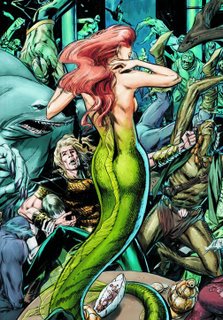 Kurt Busiek (!) and Butch Guice’s (!!) salmon and sorcery series, Aquaman: Sword of Atlantis.
Kurt Busiek (!) and Butch Guice’s (!!) salmon and sorcery series, Aquaman: Sword of Atlantis.
A reinvigorated Teen Titans in which Geoff Johns (!!) promises a new, more character-driven approach to writing the team and Tony Daniel promises a more polished, realistic style of art (!). More Birds of Prey by Gail Simone (!!).
More Birds of Prey by Gail Simone (!!). All this and a gorgeous-looking, shrouded in mystery, all-new Flash series?
All this and a gorgeous-looking, shrouded in mystery, all-new Flash series?
Am I dead? Is this fanboy heaven?
Frankentstein vs. Swamp Thing: Red Mars/Blue Heaven (DC/Vertigo)
Grant Morrison and Alan Moore (writers) / Doug Mahnke and Rick Veitch (artists)
 DC’s greatest monsters go head-to-head in a battle for supremacy over monochromatic planets and other, nebulously defined metaphysical stakes. Four issues. Prestige format. Tell me this isn’t gold.
DC’s greatest monsters go head-to-head in a battle for supremacy over monochromatic planets and other, nebulously defined metaphysical stakes. Four issues. Prestige format. Tell me this isn’t gold.
Some Kind of Goatee Measuring Contest? Green Arrow #59 I may be reading too much into things, here, but I find it curious that our goatee-sporting hero is locked in a death match with not one but two villains with ’stacheless Norris Skipper or “petit” goatees.
I may be reading too much into things, here, but I find it curious that our goatee-sporting hero is locked in a death match with not one but two villains with ’stacheless Norris Skipper or “petit” goatees.  Is Winick implying some connection between ’stacheless goatee styles and criminality? Is there something “unbalanced” about Merlin and Dr. Light’s naked upper lips that hints at a more disturbing imbalance within?
Is Winick implying some connection between ’stacheless goatee styles and criminality? Is there something “unbalanced” about Merlin and Dr. Light’s naked upper lips that hints at a more disturbing imbalance within?
Alpha Flight: Poised for Takeoff? Joe Quesada’s weekly (daily?) spin sessions at Newarama usually aggravate the hell out me (exhibit A), but like the proverbial traffic accident bystander, I cannot look away. This time, at least, there was some good news:
Joe Quesada’s weekly (daily?) spin sessions at Newarama usually aggravate the hell out me (exhibit A), but like the proverbial traffic accident bystander, I cannot look away. This time, at least, there was some good news:
Well as you know, Alpha Flight had a little bit of trouble in the most recent issue of New Avengers. Heck, I hear that the entire nation of Canada has declared war on Brian Bendis. Anyway, just so Alpha flight folk don’t spend the entire weekend bummed out, don’t worry too much because there are big plans in the works for our Canadian super team. I think when it all comes to fruition; all our Marvel faithful north of the border are going to be thrilled.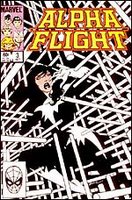 I’m always fascinated to see how Canada looks when viewed from the south, but even more than that, I just flat out like Alpha Flight. In its first couple of years the original title showcased some of the best work of John Byrne’s writer/artist career (certainly some of his best covers!), and the series went on to become one of my favorite second-string Marvel super team books (in the tradition of the Defenders and the West Coast Avengers). I hated—in fact, loathed—the “comedic” Alpha Flight revamp of a few years ago, so I’m very happy to hear that there are plans afoot for a relaunch. Of course, it could always end up being a giant cock-up. Fingers crossed.
I’m always fascinated to see how Canada looks when viewed from the south, but even more than that, I just flat out like Alpha Flight. In its first couple of years the original title showcased some of the best work of John Byrne’s writer/artist career (certainly some of his best covers!), and the series went on to become one of my favorite second-string Marvel super team books (in the tradition of the Defenders and the West Coast Avengers). I hated—in fact, loathed—the “comedic” Alpha Flight revamp of a few years ago, so I’m very happy to hear that there are plans afoot for a relaunch. Of course, it could always end up being a giant cock-up. Fingers crossed.
Here’s a great Alpha Flight fan site for anyone who shares my excitement.
MKMK: The Moon Knight We Never Knew We Wanted? And while I’m on the subject of exciting Marvel relaunches, let me just note that I’m eagerly anticipating the new Marvel Knights Moon Knight series by Charlie Huston and David Finch. At first I was disappointed that David Finch was leaving New Avengers after such a short stint, but when Bendis’s writing on New Avengers took such a harsh nosedive I could only think that Finch had dodged a bullet. I’ve never really followed Moon Knight’s previous adventures very faithfully, but I (like everyone else) love the character’s look. (Perhaps his blankness makes him more amenable to our fanboyish projections and pretensions to, uh, y’know...badassishness.) Normally, I don’t go in for the kind of mean streets bone crunching that Huston is promising, but this new series looks too damn cool to resist. For more, check out this interesting interview with Huston at Buzzscope.
And while I’m on the subject of exciting Marvel relaunches, let me just note that I’m eagerly anticipating the new Marvel Knights Moon Knight series by Charlie Huston and David Finch. At first I was disappointed that David Finch was leaving New Avengers after such a short stint, but when Bendis’s writing on New Avengers took such a harsh nosedive I could only think that Finch had dodged a bullet. I’ve never really followed Moon Knight’s previous adventures very faithfully, but I (like everyone else) love the character’s look. (Perhaps his blankness makes him more amenable to our fanboyish projections and pretensions to, uh, y’know...badassishness.) Normally, I don’t go in for the kind of mean streets bone crunching that Huston is promising, but this new series looks too damn cool to resist. For more, check out this interesting interview with Huston at Buzzscope.
More Quizilla Nonsense
Which Peanuts Character are You?
You are Rerun!
Which Peanuts Character are You?
brought to you by Quizilla
How Will “Jim Roeg” be Defined in the Dictionary?
Jim Roeg -- [adjective]: Extremely extreme! 'How will you be defined in the dictionary?' at QuizGalaxy.com |
I have charm?

rants
Button-Crazy
I went crazy this weekend. Button-crazy. I’m still not entirely sure what happened.
 A kind gentleman from Blogflux sent me a link to their free button-maker some time ago and I ignored it quite happily for several months. But then, I was bored and clicking around, and all of a sudden, I was making buttons. Crazy numbers of buttons in every sort of color and design. Once I started, I found it difficult to stop. I set a challenge for myself: to make buttons for all the links on this site. Buttons that would ape the basic color-scheme of the site to which they were attached (something that proved to be more difficult than it seemed as Blogflux’s color choices are not as extensive as Blogger’s). It was a fun process, rather like painting on a grain of rice, I expect. There is something extremely enjoyable about trying to be creative within a fairly narrowly prescribed set of parameters, and working with Blogfux’s button-maker was a prime instance of that. My hope was that, by the end, I would have a set of links that were easier to navigate because the colors of the buttons would remind me of the sites to which they led.
A kind gentleman from Blogflux sent me a link to their free button-maker some time ago and I ignored it quite happily for several months. But then, I was bored and clicking around, and all of a sudden, I was making buttons. Crazy numbers of buttons in every sort of color and design. Once I started, I found it difficult to stop. I set a challenge for myself: to make buttons for all the links on this site. Buttons that would ape the basic color-scheme of the site to which they were attached (something that proved to be more difficult than it seemed as Blogflux’s color choices are not as extensive as Blogger’s). It was a fun process, rather like painting on a grain of rice, I expect. There is something extremely enjoyable about trying to be creative within a fairly narrowly prescribed set of parameters, and working with Blogfux’s button-maker was a prime instance of that. My hope was that, by the end, I would have a set of links that were easier to navigate because the colors of the buttons would remind me of the sites to which they led.Another part of this reorganization of my links was a switch from listing sites by title to listing them by the blogger’s name. I am, at best, a sporadic visitor of other blogs—mainly because I’m already burning the candle at both ends and never seem to have enough time. I am, unfortunately, a binge visitor rather than a regular reader. I also have a terrible memory. Consequently, except for the very few sites that I do check out on a semi-regular basis, I’m always forgetting whose site is whose and even what each site is about. The switch from titles to names combined with the color coding of each button was designed to identify each site more distinctively and to embed each blog more firmly in my memory as well as in my sidebar.
On the whole, I think the new scheme is working, though with somewhat mixed results aesthetically. The colors are a bit brighter than I’d like, and I will no doubt return to Blogflux to redesign some of the buttons at some point. More talented people than I have also shared some of their own self-designed buttons with me—notably Neil from Neilalien who designed a really cool button for his own site some time ago. (Thanks Neil!)
The main problem with my new scheme is that group blogs get short-changed in the name department: there isn’t room for two names on a single button, so I am forced into a cruel decision: either I must sacrifice the fundamental principle of the new order (names instead of titles) or I must design anywhere from 2-12 buttons for a single group blog to represent the name of each blogger who contributes to it. This would be no problem for a Blog like John Jakala and Ed Cunard’s The Low Road, but would be a nightmare for, say, Snark Free Waters. And what would be the point anyway, since the links are merely supposed to be functional, not actually an index of individuals? For me, this was one of those unusual situations in which my deranged system-building impulse and fascist aesthetic sensibility were actually smashed into submission against the brick wall of common sense. I went with option A and sacrificed the cornerstone of the new regime, resulting in a blogroll made up of a messy combination of the names of individual writers and the (often abbreviated) titles of group blogs. I’m still smarting from this compromise, but learning to live with the pain.
The ultimate appeal of the buttons, for me, is their orderly appearance. I love the symmetry of those two straight lines of buttons in the same way that I love reorganizing the kitchen cupboards or my filing cabinets or my list of Favorites. Real life may feel like a chaotic mess, but at least I’ve got buttons.
And there are more to come. Oh yes.
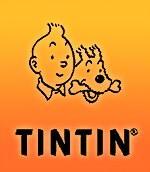



15 comments:
James Robinson’s (!!) 8-part Batman/Detective Comics crossover, followed by Grant Morrison (!!!) becoming the regular writer on Batman.
Did you forget Paul Dini(!!!) on Detective?
Ulp! Not only that, but I forgot that Rags (!!!) was going to be pencilling Dini's Detective run. Is there any end to the good news?!? Oh yeah, and there's the just-announced Gail Simone Atom series... Oh, and...
I'm a little surprised about it, but I'm with you on your excitement for the OYL DCU. After Countdown, I really thought I was done with DC for a while, but Morrison and Simone have kept me hanging around long enough to get really interested to see what sort of stories and storytelling possibilities are in the pipeline...
So much to take in! I think I'm going to have to cave and buy All-Star Superman. I love, love the super-powerful, super-smart Superman we used to have. The Byrne clunker is just boring to me, and sooooo 80's.
What? Is no one excited about Annihilation and Civil War and Planet Hulk and the ten other Universe changing, one of a kind, internet breaking, Marvel crossovers all written by Brian Bendis??!??? Can I get a woop woop for Marvel? Anybody? Anybody… Oh forget it.
Heh heh--yeah. I'm pretty much just gushing about DC these days, and clearly I'm not the only one! Still, I have to admit that I'm curious about Marvel's Annihilation event and even (tentatviely) Civil War. Ever since his amazing work on Flash Scott Kolins has been a favorite of mine and I like the look of his Annihilation pages. I also really have a fondness for "cosmic" Marvel, so if there's even a tiny chance that Annihiliation won't be a piece of shit, I'm at least going to try it out. I'm not as sure about Civil War, but I dipped my toe in and bought Amazing Spider-Man 529 this week. (The first Spider-Man comic I've bought in a lonnnggg time.) I was surpirsed to find it quite enjoyable--the no-prize blooper about Mary Jane's magically-healing arm from "The Other," notwithstanding. I dunno. Marvel might be on the upswing creatively, which would certainly be a nice change of pace.
Oh, and gorjus - glad to hear you're caving in on All-Star Superman!
I have mixed feelings about Byrne's 80s Superman run--I loved the Superman in Space story illustrated by Kerry Gammill and a couple of the new villains (esp. Silver Banshee), but there was much to deride too, and that "Man of Steel" miniseries that spun out of Legends was pretty dull as I recall. At the time, though, it was exciting to feel that all these characters were accessible again, and the current spate of revamps has me excited about the DCU in the same way that I was back then, only moreso, because this stuff is by and larger better (though Perez's Wonder Woman was awesome). With all the great teams on the marquee DC titles OYL, it looks like I may be buying all the Superman, Batman, and Wonder Woman titles again for the first time in about ten years...
Great reading of All Star Supes #2. Like you, I'm in awe of the synergy shared by Morrison and Quitely--this run is destined for legendary-status.
And I'll go on record for Morrison doing Bluebeard _better_ than Angela Carter--I found 'The Bloody Chamber' to be a morass of cliched tropes and metaphors (which is part of the Carter's point, no doubt, but I couldn't get past them).
Hey, Joe - thanks! And about Angela Carter: "The Bloody Chamber" (the Bluebeard story) is, in my view, the weakest story in that collection. It has the most obvious (and most hackneyed) feminist moral. The later stories, though, especially the "Erl-King" and "Wolf Alice" are favorites of mine--in part because of the way that they challenge the more simplistic tropes and cliches of "The Bloody Chamber." My take on the collection as a whole is that it is Carter's quasi-"French feminist" critique of the kind of second wave feminism for which the first story is a fairly obvious allegory. Plus, I like the combination of violence and eroticism in the later stories--in a purely detached and analytic sort of way, of course. I don't think Morrison is going there, though (at least not in A-S Superman)! (It'd be fun to know if he'd read Carter, not that it matters.)
As usual when I read your stuff, I have to rethink my own furshluggener opinions.
That being said, I still didn't like All-Star Superman #2.
Don't get me wrong, I agree with your assessment that this may turn out to be the greatest Superman team ever, especially because I've never particularly liked Superman. However, even though I appreciate the allusions Morrison makes throughout the issue, that's all they are - allusions - and as I mentioned in my original review, nothing really happens in this book, and I get annoyed with plotless fiction really quickly. I have no doubts that Morrison will bring us back on track, but this issue bugged me because it seemed to showcase all of Morrison's "weaknesses" (I say that because they're still fun) - crazy ideas looking for a home - without his strengths, which, for me at least, is making us care about these characters. So far, at least, I don't really care about Clark and Lois.
Oh, and Meltzer on JLA? It must be asked, and I apologize for the cheap shot - how long before Wonder Woman gets raped? Or, if he's really feeling edgy, one of the men gets raped?
Thanks for those comments Greg. I just reread your review of ASS#2 - I love that list of "things that sound clever but don't advance the story at all." I also see what you mean about the two Morrisons and I definitely concur about the need for plot.
The thing is, I really do see a plot in this issue: Lois thinks that Superman is going to harm her, but it turns out that he's making her a birthday present. Granted, it's a pretty minimalist plot! But the minimalism works for me because the point of the story (I think) is really to explore the pathos of Superman's situation. In this regard, I would defend the extended and seemingly aimless tour of of the Fortress as (mostly) contributing this theme in some of the ways I suggested in my review.
Eg. the God-like Superman of the pet sun-eater scene is meant to contrast specifically with the reduced Superman of the mirror-gazing scenes. There is also the irony of Superman dying because of exposure to the sun, yet keeping a tiny sun-eater as a pet and manufacturing mini-suns--almost as if he is trying to assert some mastery over the thing that has mastered him. I talked about this scene as a contrast to Superman's diminished state, but there's pathos in it too because his "mastery" is heavily ironized by his current condition.
The "dwarf star" key also serves a purpose in relation to Lois's story: even without the Bluebeard allusion the key clearly connotes knowledge, so Lois's inability to pick it up symbolizes her misunderstanding of the nature of Superman's secret room throughout the issue. At the end, she learns the secret of the room and is presented with her supersuit; in other words, her gain in knoweldge literally means that she will be able to pick up that key!
Perhaps none of this adequately answers your criticism that there isn't enough of a plot here--quite possibly, there just isn't. And I admit that there's lots of superfluous stuff here too, as you point out--that chessboard, for intance (which made me think dirty thoughts). But then, at the end of the day, this is all a matter of taste. The thinness of the plotting is made-up for, for me, by the intricacy (and astuteness) of the symbolism and its emotional charge. I'm almost inclined to argue that Morrison is writing something like narrative poetry (where the symbolism is arguably just as important, or even more important, than the plot) rather than more straightforward narrative, where the plot carries more weight.
Along these lines, I think I agree with you about the flatness of the characterization--so far I don't really care that much about Lois and Clark as characters either. But then, I don't think that Morrison is really all that interested in characterization here so much as in trying to tell old-fashioned science fiction stories, where the characterization was always secondary to the wild ideas and the affect they evoke.
Not sure if all that's coherent, but your comments and review really got me thinking! Thanks.
As for cheap shots: always welcome here!
I’m a little surprised when you guys suggest that plotting is one of Morrison’s strong points. I have only recently become particularly interested in Morrison, so I haven’t read a tonne of his work; some Animal Man here, some New X-Men there, a bit of JLA, etc. I have, however, been working my way through the Invisibles trades, which I have been utterly adoring.
But what I find so wonderful about the Invisibles is certainly not the plotting! I remember going through that first trade, trying to figure out where each issue ended. So issue one had 60 pages, but issue to had 24… huh? You know what I mean? The crazy structure of the whole thing made it difficult to break it down into chapters, to get an understanding of what it was like in serial form. The story seemed to just wander all over the place, in the most wonderful, wacky way. I always thought the chaotic plotting was, in way, a reflection of the anarchistic doctrine of the material itself.
When I think of Morrison, I think of all of these amazing crazy stories that seem to defy plot. I’m certainly not going to buy the next Invisibles trade expecting a tightly woven, narrative driven story.
Am I just thinking of an “old” Morrison? Has he become a more plot oriented writer?
Okay, now I’m going to go watch all the topless scenes of the mom from Spy Kids in Sin City. Which I enjoy in a “purely detached and analytic sort of way, of course.”
Well, Thomas, I don't like Invisibles for just that reason - the meandering of the whole thing. However, Doom Patrol, which is definitely "old" Morrison and remains perhaps my absolutely favorite comic book EVER, was very tightly plotted AND had plenty of room for Morrison's wackiness AND had a lot of beautiful human interaction. He certainly can do all three, and occasionally he doesn't, which bugs me.
Doom Patrol - slowly coming out in trade paperbacks - buy yours today!
Thomas, Greg,
I think The Invisibles has so much plot that it can often appear chaotic, but believe me, the more you read, the more structure becomes apparent.
If you've just finished the first trade, you might be interested in reading what I've been writing about the 'Arcadia' storyline, starting here and continuing on in the category link at the bottom.
Sorry for spamming your comments, Jim...
Anyway, Jim, your continuing wonderful analysis has convinced me that I cannot wait for the trade - I will be buying ASS individually from now on - and I'll buy the trade... Morrison and Quitely are worth it.
You know, given that old trades never reprinted letter columns and modern comics no longer have letter columns, I reckon a modern trade (of something like ASS) could do with some reprinted blogosphere commentry...
Ah, the great Invisibles/Doom Patrol schism. My own taste definitely falls more on the Doom Patrol side of things, but I take your point, Thomas, about the (seeming?) chaos of the plotting mirroring the story's content. And btw, David, spam away! Those are some fascinating notes and essays on the Invisibles. Truth be told, I have a sort of guilty relationship with that comic. I always felt I should have enjoyed it more and imagined that if only I worked at it a bit, it would be sublime. But as I've said before, I really am an appallingly lazy reader. I just don't like to work that hard. So, like Greg, I prefer Morrison's slightly less chaotic stuff: Doom Patrol, We3, New X-Men, ASS, even Sea Guy. I did like the Filth, but even that was tilting a little too far into wacked-out Morrison nuttiness for me. Seven Soldiers strikes a perfect balance, on the whole. One day, though, I am going to sit down with Invisibles again. There are some parts of that first run of the series that I really loved--especially the stuff illustrated by Jimenez.
Filipe - I agree about Busiek on Superman. And I'm really enjoying the current Green Latern Corps mini too. I'll definitely be buying the new Gibbons series. My only reservation about the new Corps is that I feel like Gibbons and Johns are playing the cop-precinct angle a little too heavily. It's getting distracting. I'm thrilled by all those alien GLs, though. The new GLC series should be great.
Sasquatch, Marvel Legends Series 11 click the link if you would like to see a Photo Review of the Sasquatch action figure. Possibly the best one ever made by the Marvel Legends series! By the way, I do/did read your blog, and I enjoy it, Thanks!
Post a Comment